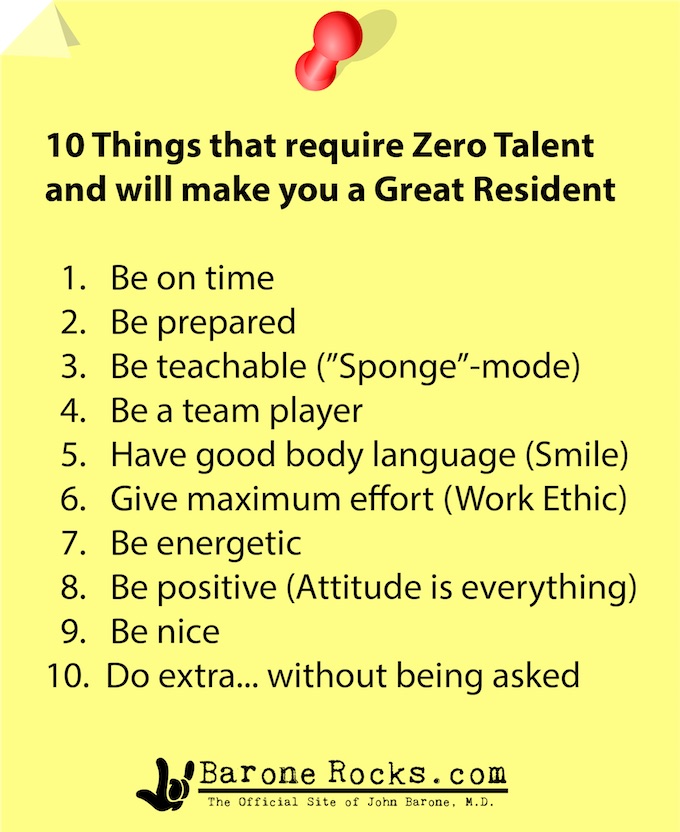How to Rock Your Clinical Rotations
By Elizabeth McKinnon
It’s every medical student’s dream. You’ve just slain the beast known as Step 1 and now you’re getting ready to don the white coat on the daily instead of pouring yourself over the biochemistry books and reviewing the muscles of the forearm. But when it comes to exchanging the basic knowledge for the practical skills, do you think you have what it takes to succeed?
For better or worse, the third year of medical school is not that different from the basic science years. For one thing, if you thought the studying was over, you’re dead wrong. And that crucial lack of sleep you we’re dealing with during Pathology? You’ll feel the same way when you’re on the Surgery clerkship and there’s nowhere to rest your head whilst you’re retracting someone’s abdominal wall. Though this transition is welcomed after the long two years of basic science preparation, this new phase in your medical education certainly does not come without a challenge. It just comes with a new, more mature set of problems.
But fear not, friends. That’s why I’m here. As a fourth year student looking back on my third year clerkships, I feel that I can now bestow some of my favorite tips for rocking the wards upon you students who are bringing up the rear and forming the newest set of clinically-apt future doctors. Though not every single one of these is going to be your cup of tea, they worked for me and thus they will work for you. So without further ado, here are my top 5 tips for succeeding in your third year clerkships:

1. Buy a good watch and NEVER be late.
 It sounds almost too easy. Who cares if you’re a few minutes late to rounds? The coffee barista in the lobby works a little slower, ‘mkay?
It sounds almost too easy. Who cares if you’re a few minutes late to rounds? The coffee barista in the lobby works a little slower, ‘mkay?
Being on time is actually one of the simplest things you can do that makes a big difference. It might not seem like a big deal, but attendings pay attention to which students are punctual and which ones are creeping into the cue looking rushed and underprepared.
During one of my final evaluations, a senior resident complimented me on how punctual I had been throughout the rotation. “It’s very important,” he said. “It shows respect. Being late says that you don’t care about the neither the subject matter nor your colleagues. And if you cannot show up on time, how can you adequately care for patients?”
Give yourself extra time to get ready in the morning. Expect things to go awry and plan ahead. For most of my rotations, I had to take the subway to the hospital. Most mornings worked out beautifully thanks to the miracle of the high-speed rail, but since stuff happens I always made sure to leave an hour earlier than the time I needed to be in the hospital. And would you know it, one day the train broke down and I had to walk to the hospital. And since I gotten in the habit of being on the train and hour before my ETA, I had plenty of time to shake off the misfortune and walk to the hospital instead.
On the plus side, if you show up early to the hospital, check in with your residents so that they see you. They’ll admire the fact that you’re there with time to spare. This will not only benefit you in evaluations, but they may mention it to your attending, too.

2. Don’t leave the “shelfs” to sit on the shelf.
I get it. You’re studied out. After Step 1, you thought you’d never be able to pick up a book again without crying and having flashbacks about glycolysis and positive predictive value. But unfortunately, the reason Step 1 is called Step 1 is because there are Steps that come after 1 is done to ensure your licensure as a physician.
Throughout the course of your third year, you will need to take shelf exams. You will have to take one after each clerkship (Internal Medicine, Surgery, OB/GYN, Psychiatry, and Pediatrics) is finished. The truth is that these exams aren’t just to test your knowledge and factor into your finals grades, but they exist to reinforce your understanding of certain subject matter at each stage of your third year. So in essence, you owe it to yourself to really study for these things. They matter because your Step 2 CK exam matters. And the more you study during the year, the less you’ll have to do when you take the next Step.
Buy a reputable review book and start reviewing during the first week of your clerkship. Spend a little time every day doing some reading, and then test yourself using a question bank. Towards the last week of the clerkship, spend as much studying time as you would for a basic science exam. Remember, the better you do on these tests, the better you can estimate you will do on the boards.
3. Dress for the job you want, not the job you have.
One thing for me that stands out as a big difference from basic sciences is attire. When I was a 1st year, I lived in yoga pants and flip flops and occasionally when I had to leave the house, I threw on some makeup and prayed my hair would stay flat. But during the clerkship years, appearance plays a slightly bigger role in representing yourself and your school.
You don’t necessarily have to purchase a three-piece suit and shiny shoes, but you should start everyday picking out a clean shirt to wear and dress pants. Never wear flip-flops, stretch pants, or jeans while in the hospital. If you need to wear scrubs, sneakers are not a problem.
 For the ladies, skip the pancake makeup and go for a more natural look. Kim Kardarshian-style “smokey eyes” are okay for selfies and parties, but it’s more of a distraction on the wards if you look like you’re headed for a Hollywood premiere. Let your natural beauty shine through! For dress, skirts are okay in most clinical settings when worn with panty hose, but make sure that the skirt is longer than your fingertips when standing with your arms flat against your body. Otherwise you run the risk of giving your cardiac patient another coronary!
For the ladies, skip the pancake makeup and go for a more natural look. Kim Kardarshian-style “smokey eyes” are okay for selfies and parties, but it’s more of a distraction on the wards if you look like you’re headed for a Hollywood premiere. Let your natural beauty shine through! For dress, skirts are okay in most clinical settings when worn with panty hose, but make sure that the skirt is longer than your fingertips when standing with your arms flat against your body. Otherwise you run the risk of giving your cardiac patient another coronary!
Lastly for the ladies, I always felt that you should spend the first day with your hair up to see if you can work with it down. If you can, go for it. If not, keep it pinned back. And just be careful in your Psych rotation with ponytails – agitated patients can pull them and injure you. The same thing goes for the men with their ties.
So all in all, remember the kid who wore a tank top in middle school and got sent home by the principal?
Doctors will do the same thing if you’re not appropriately dressed. So don’t be that kid.
4. Break out the collagen…and grow a thicker skin.
One time-honored tradition of being a medical student, also known as the lowest person on the totem pole, is the constant possibility that you will be yelled at. It’s almost universal. At some point, a doctor or a nurse or even a paramedic is going to scream at you, and you’re going to be upset about it.
I remember one night during a C-section, my OB attending yelled at me for cutting the wrong suture. He was furious and I was on the verge of tears. Discouraging words were exchanged and I spent the rest of the night shift holed up in the cafeteria and nursing a snack. I couldn’t believe that someone could yell at me when I was trying so hard to please.
So what do you do in that situation?
LET IT GO!
The consequences of getting angry and yelling back FAR outweigh the benefits of getting your feelings off your chest. Never fight back. Often when someone yells at you in the hospital, they are projecting their own negative attitudes and feelings onto a safer object (AKA: You). This means that doctors and nurses have their own crap to put up with, and if you’re there for the frustration to be transferred, you’ll be the one to bear the brunt of it. It’s often not personal, so don’t take it as such.
Keep in mind that one of the ways to stand out in your rotation is to volunteer to do stuff and take risks. Interested in learning to take blood? Ask someone to teach you. Want to learn more about that attending’s research on COPD? Ask if you can help him with gathering information. Attendings will be flattered if you show initiative when it comes to learning more. This is a quality they look for in residents, so it is so refreshing to find it in a student. But again, don’t be disheartened if they do not want your help or they don’t make eye contact during noon conference. Everyone has their own stuff to deal with.

5. The only direction to go is up.
Medicine is more than a job. It is a lifelong commitment to the well-being of others. One day, you will be working as a doctor, and for every bump in the road you experience as a student, it’s one more thing you can file away in order to become a better one.
You won’t always be a medical student. Third year will end, fourth year will begin, and pretty soon you will be a resident and you’ll wonder, “Where did the time go?” So while you’re still a medical student, take the time to reflect on your goals. Let yourself be attracted to fields of medicine you’ve never considered before. Allow yourself time to relax and recover, and don’t get so caught up in the competitive nature of medical school. It’s not worth it to compare yourself to others, because you are a unique entity who has a place in the medical field. Never forget how valuable your skills are and especially how valuable YOU are.
You will finish your clerkships. You will graduate. And you will become a doctor. There is nothing holding you back from accomplishing your dreams. Race towards the finish line with a positive attitude, but enjoy the view as you do. You’ll remember these years of your life fondly, where you entered medical school as a ‘flightling’ and left a professional. The hardships you will face only sweeten the prize at the end of the long journey.
You can do it. Believe in yourself. You will do big things.
Dr Barone and I wish you all the best in your third year of medical school!!!!
Category: Wards





 For the ladies, skip the pancake makeup and go for a more natural look. Kim Kardarshian-style “smokey eyes” are okay for selfies and parties, but it’s more of a distraction on the wards if you look like you’re headed for a Hollywood premiere. Let your natural beauty shine through! For dress, skirts are okay in most clinical settings when worn with panty hose, but make sure that the skirt is longer than your fingertips when standing with your arms flat against your body. Otherwise you run the risk of giving your cardiac patient another coronary!
For the ladies, skip the pancake makeup and go for a more natural look. Kim Kardarshian-style “smokey eyes” are okay for selfies and parties, but it’s more of a distraction on the wards if you look like you’re headed for a Hollywood premiere. Let your natural beauty shine through! For dress, skirts are okay in most clinical settings when worn with panty hose, but make sure that the skirt is longer than your fingertips when standing with your arms flat against your body. Otherwise you run the risk of giving your cardiac patient another coronary!






















